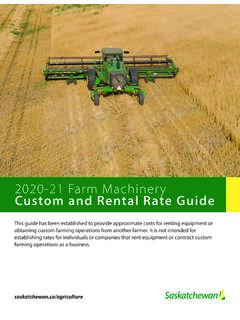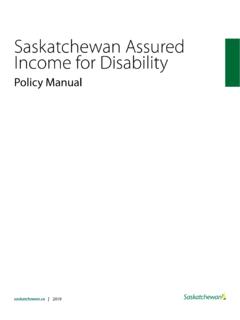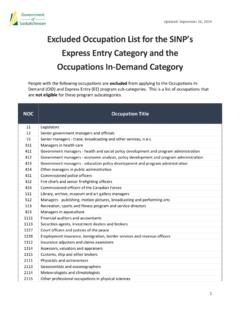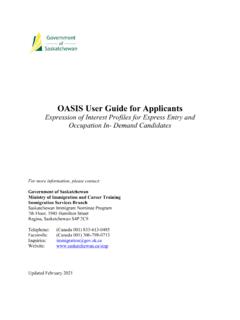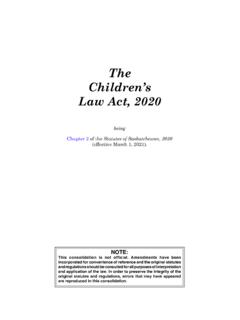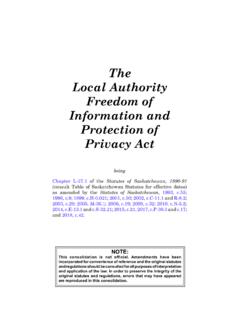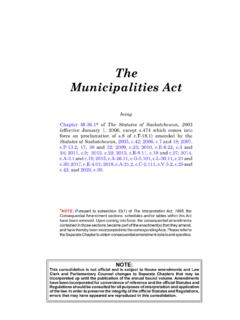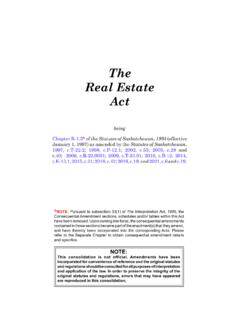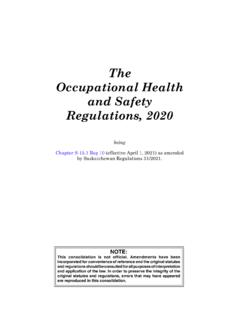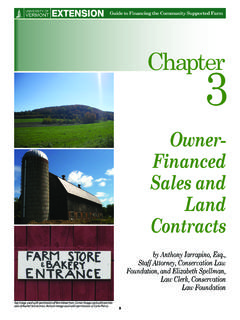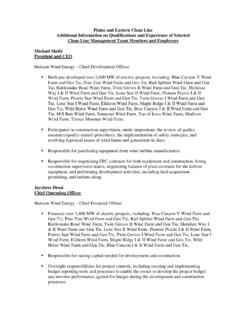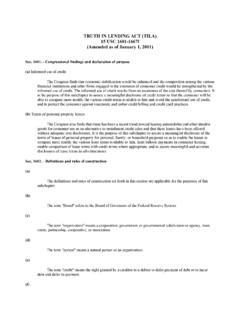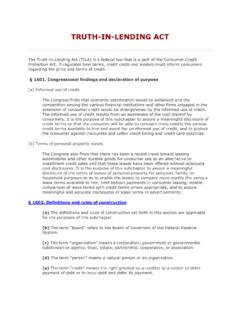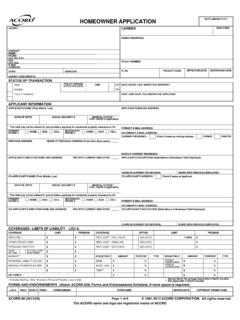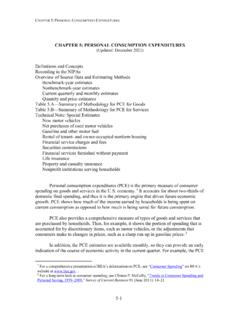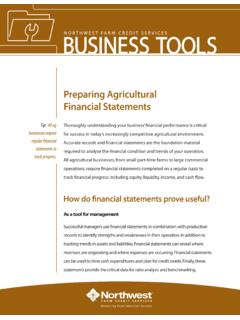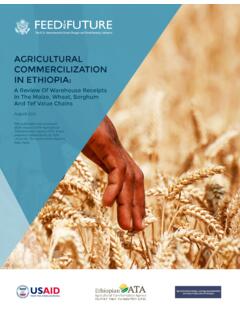Transcription of 2018-19 Farm Machinery Custom and Rental Rate Guide
1 2018 -19 farm MachineryCustom and Rental Rate GuideThis Guide has been established to provide approximate costs for renting equipment or obtaining Custom farming operations from another farmer. It is not intended for establishing rates for individuals or companies that rent equipment or contract Custom farming operations as a of ContentsIntroduction ..3 Caution ..3 Methodology ..3 Assumptions ..3 Using the Guide ..5 Additional Information ..5 Factors to Consider When Custom Hiring ..6 New Information for 2018 -19 Guide ..6 Summary ..9 Power Units ..10 Two Wheel Drive Tractors ..10 Front Wheel Assist Tractors ..10 Four Wheel Drive Tractors.
2 10 Tracked Tractors ..11 Harvesting Grain ..12 Self-Propelled Combines ..12 Combine Headers ..12 Front Wheel Assist Tractors ..12 Swathers ..13 Grain Cart ..13 Powered Auger ..13 Grain Auger (PTO) ..14 Grain Vac ..14 Harvesting Hay ..15 Self-Propelled (SP) Forage Harvester ..15 Headers for SP Forage Harvester ..15SP Mowers/Conditioners ..15 Pull-Type (PT) Mower/Conditioners ..16 Balers ..16PT Bale Movers (Self Load/Unload) ..17SP Bale Mover ..17 Seeding ..18 Air Drills with Independent Openers ..18 Air Hoe Drills ..18 Air Disc Drills ..19 Air Seeders ..19 Other Row Crop Planters ..19 Soil Preparation ..20 Cultivators.
3 20 Harrows ..20 Vertical Tillage Tools ..20 Land Roller ..21 Land Scraper ..2112 Sprayers ..22 High Clearance Sprayer ..22 Miscellaneous ..23 Post Pounders ..23 Vertical Feed Mixer ..23 Grinder Mixers, Feed Mixers, and Bale Processors ..23 Manure Spreader (Solid)..24 Appendix A: Cost of Hauling Grain from Field to Yard ..25 Appendix B: Rental rates for farm Buildings and Bins ..26 Appendix C: Combine Classifications ..27 Appendix D: Assumptions for Machinery Cost Calculations ..28 Appendix E: Fuel Consumption Based on Engine Size ..29 Appendix F: Conversion Tables ..30 IntroductionThis Guide has been established to provide approximate costs for renting equipment or obtaining Custom farming operations from another Guide is applicable for two different situations.
4 One is to suggest an equitable price for both parties when one farmer either rents a piece of equipment from another farmer or hires the other to do a farming operation ( , seeding, spraying, harvesting, etc.). In this situation the period of rented operation is usually relatively small in proportion to the use by the owner. The other use is when farmers share equipment and need to establish the value of the Machinery and/or farming operation that is being contributed to each farm . CautionNearly every situation has circumstances and conditions which are unique. This Guide cannot address every situation. It is up to the individuals to recognize special circumstances and make suitable adjustments to cover the differences.
5 This Guide also makes many assumptions that can have a large impact on the suggested Rental and Custom rates ( , annual hours of use, financing costs, etc.) It is the responsibility of both parties to agree to acceptable terms before entering into a contract. MethodologyOne of the most critical steps in establishing a Rental rate is defining the cost of equipment ownership and the cost of operating and maintaining the equipment. Since it is likely that some factors will change for every situation, it was necessary to develop the following set of assumptions that form the basis for calculating costs. Cost of ownership includes the cost of depreciation of the equipment due to use and years in service.
6 Cost of ownership also includes an investment cost ( , the cost to borrow money to purchase the equipment and/or the lost interest revenue if that money had been invested), and housing/insurance costs. The cost of ownership also includes a margin to cover unexpected incidentals or fluctuations in equipment costs. To generate a suggested Rental rate on a $/hr basis, the cost of ownership was tallied for the life of the equipment, then the total hours of use over the life of the equipment was estimated to generate a Rental rate on a $/hr basis. Operating costs include repair and maintenance (broken and worn parts, oil, filters, and labour for repair and service), and fuel use.
7 In addition, there are operating labour costs and a margin to cover unexpected incidentals and specific conditions that affect operating costs. AssumptionsIn all cases it is reasonable to assume that rented Machinery is in good repair and is capable of performing the intended task in the same manner and at the same productive rate as similar machines of equal specification, ratings or category regardless of age. Cost of OwnershipEquipment Depreciation: The cost of equipment depreciation accounts for purchase price, salvage value, and years of service (also called optimal life). In this Guide , the purchase price is based upon the average of the base list price and the list price for that machine with all available options.
8 For each piece of equipment and size category listed in this Guide , a significant effort was made to gather information from a minimum of two manufacturers. Note that all purchase prices used in this Guide are manufacturer s suggested retail prices (MSRP). 3 The years of service (or optimal life) is defined as when the equipment value has declined to 1/3 of its original value. Therefore, the salvage value is assumed to always be 33 per cent of the original purchase price, but the years of service varies for each piece of equipment. In reality, a machine s years of service depends on many factors and may vary greatly in years and hours.
9 The optimal life and estimated annual hours of use for all equipment used in this Guide is listed in Appendix D. For this Guide , the depreciated value (purchase price salvage value) is split equally among the years of service of the equipment because, after the first year of use, most Machinery depreciates at a fairly consistent rate over the next 10 to 15 years (with typical use). Note that when calculating the depreciated value for tax purposes (capital cost allowance), the depreciated value changes from year to year depending on the allowable rate for each class of equipment. Most farm equipment falls under class eight or class 10 which allows an annual depreciation rate of 20 per cent and 30 per cent, respectively.
10 This means that the depreciated value is relatively high over the first few years of ownership and steadily decreases until the equipment has little value. This length of time (optimal life of equipment) is not defined by the capital cost allowance. The total depreciated value using either method (equally split among the years of optimal life or based on capital cost allowance rates ) will be relatively close if a reasonable optimal life of the equipment is assumed. Financing Cost: It has been assumed that 50 per cent of the initial price is covered by the value of a trade-in and/or a cash payment with the remaining 50 per cent financed.
